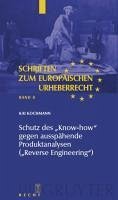The development and legal purchase of "know-how" are costly. Accordingly, for companies in possession of "know-how" it is of vital interest to ensure that competitors do not gain access to their specialized knowledge. Taking this fact into consideration, this work concentrates on a problem area that has yet to be debated in depth, namely the distinction between protected and unprotected know-how in the case of "reverse engineering", which is the acquiring of construction and programming knowledge by dismantling and reverse development.
Dieser Download kann aus rechtlichen Gründen nur mit Rechnungsadresse in A, B, BG, CY, CZ, D, DK, EW, E, FIN, F, GR, HR, H, IRL, I, LT, L, LR, M, NL, PL, P, R, S, SLO, SK ausgeliefert werden.
"[...] ist das Werk von Kochmann ebenso für den Praktiker wie für den Wissenschaftler ein wertvolles Hilfsmittel, sich mit zahlreichen Facetten des "Reverse Engineering vertieft und umfassend beschäftigen zu können."Thorsten Beyerlein in: Mitteilungen der Deutschen Patentanwälte 5/2010 "In summa wird nicht nur die Rechtswissenschaft, sondern auch die Praxis von dieser sorgfältigen und durchweg gut lesbar geschriebenen Arbeit profitieren. Zur Anschaffung nachhaltig empfohlen!"Christoph Ann in: UFITA 1/2010


